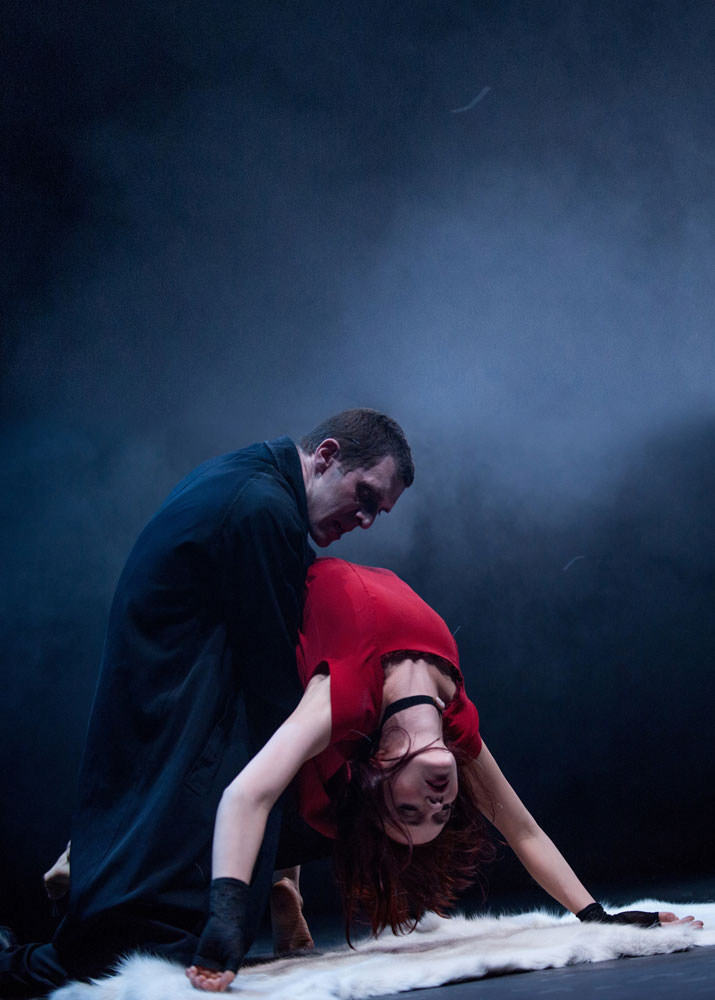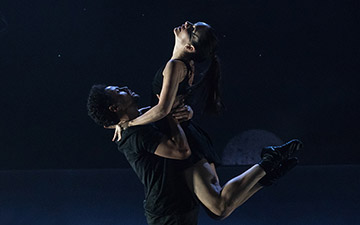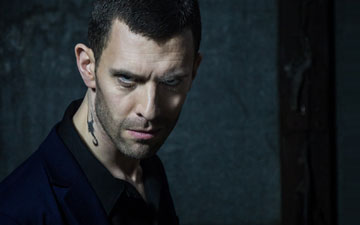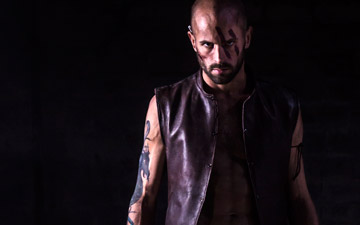
© Colin Hawkins. (Click image for larger version)
Mark Bruce Company
Dracula
London, Wilton’s Music Hall
9 October 2013
Interview with Mark Bruce
markbrucecompany.com
wiltons.org.uk
Scarcely can a performance have been as suited to its venue as this. Wilton’s is the oldest surviving Music Hall, effectively a theatre that was created out of five Georgian houses, now accessed by an ordinary door off an eerie alley that seems just too perfect a paradigm for its Whitechapel/Wapping Location. Wilton’s is ravaged by the deterioration of time but wears its age with pride. Having survived fire, riots and two World Wars – and, perfectly timed for the approach to Halloween – its decrepit charm now plays host to vampires as if it were always meant to be.
Incidentally, one of the very best things about enduring what appears now to be an hourly lottery is the Heritage Lottery Fund, which earlier this year awarded nearly £2m to complete the full preservation of this Grade II listed building. I hope the renovation preserves – above all else – the unique charm of this fabulous place.
It seems clear that director/choreographer Mark Bruce has a profound interest in the story of Dracula and, while this is his company’s sixteenth production, it entails so much rich and detailed thought that the gestation must surely have been bubbling away in Bruce’s imagination as all these prior works have come and gone. Anyone aware of his book ‘Blackout Zone’ will certainly know that darkness and supernatural folklore are central to his remarkable imagination. Here Bruce confines his creative boundaries to building a definitive reappraisal of Bram Stoker’s original 1897 novel so effectively that it demolishes the “Horror” clichés that have come to obscure the original text. And, perhaps, it helps that he does so only through an intense concentration on imagery, movement and gesture.
He finds Dracula’s voice without the need of speech. And that he is able to do so is dependent on a volcanic title performance by Jonathan Goddard. This supreme dance artist hits all the right accents through a tour de force of the myriad complexities of his character. Dracula has a heroic past and yet he is the most hard-hearted of unscrupulous villains, intent on world domination, with shape-shifting supernatural powers and an Achilles’ heel of soft-hearted flaws and issues (no garlic, crucifixes, sacramental bread, running water and sunlight, he must be invited in and can’t abide stakes to the heart). He wears an aristocratic mask of charm and courtesy and yet – of course – will simmer with menace and erupt into a ferocious rage. Goddard accentuates every subtle nuance of Dracula’s primal power mixed with the underskin of the vulnerabilities that will eventually defeat him. After a career of great dancing with Britain’s best contemporary dance companies (Richard Alston and Rambert) here he gives a remarkably powerful acting performance through movement, expression and gesture. At the curtain calls, Goddard looked so physically drained, pale and powerless that it seemed as if all the blood had been sucked from Dracula. If ever the expression that a performer has left everything on the stage were accurate then this would have to be that time.

© Colin Hawkins. (Click image for larger version)
Despite this towering performance in the vital, title role, this is anything but a one-man show and Bruce has cast the piece superbly. He finesses clever moments of humour through Lucy Westenra’s three suitors, the doctor (Wayne Parsons); the priest (Jordi Calpe Serrats) and a singing aristocrat (an excellent Michael Ball-styled cameo by Alan Vincent). Although the humorous notion of three men proposing to Lucy on the same day derives exactly from Stoker’s novel, and two of these were certainly a doctor (John Seward) and a Lord (Arthur Holmwood, Lord Godalming), the third was actually a rich Texan, Quincey Morris (indeed the man who helps Jonathan Harker kill Dracula and is himself killed in the process) and not anything like a priest. The nagging thoughts of “why a priest?” and “where’s the Texan?” became confusing undercurrents to my enjoyment of this otherwise largely faithful dramaturgical representation.
Christopher Tandy gave a steadfast account of the story’s unwitting hero, Jonathan Harker, and there were five outstanding performances by the women. Kristen McGuire was excellent as the coquettish, vivacious and tragic Lucy; Eleanor Duval brought depth to the pivotal role of Mina Murray/Harker; and the three tortured and torturing “brides” of Dracula gave the production emotional depth, range and flow, especially in enabling scene transitions to move seamlessly. While taking nothing away from the authenticity of the performances by Cree Barnett Williams and Nicole Guarino, Hannah Kidd’s uncanny and unwavering stare into the audience was alarmingly scary in a performance that was also discomfortingly sexy. While part of me was hoping to meet her walking home through the dark East End alleys around Wilton’s, the rest of me would have run a mile if I had! Which I imagine is exactly the feelings awoken in J. Harker Esq when the vampire women attempt to seduce him.
The whole gothic ambience of Wilton’s as the perfect space to tell this story is enhanced beyond measure by a stage that places the action so far above the audience seated in the “stalls”. It seems that Goddard, Kidd et al are indeed superhuman because they appear to be 2 metres tall. Bruce’s creative and technical collaborators add even more pluses to the atmospheric perfection with incredibly evocative lighting by Guy Hoare, authentic costumes and sets from, respectively; Dorothee Brodrück and Phil Eddolls, effective dramaturgical input from Lynda Radley (thus covering the oftenest of the weakest links) and wonderful puppetry and masks by Pickled Image. The way in which the horse and carriage is portrayed racing through the night is a remarkable coup de theatre; and the shipwreck off the coast of North Yorkshire is equally deftly handled, leaving the audience with the haunting image of the Demeter’s stricken captain lashed to the wheel.
This production, in this place, is about as good as it gets. If it doesn’t win a slew of awards for Mark Bruce and his team then I might just have to go walking around those East End Alleys in search of the vampire bride!

















You must be logged in to post a comment.